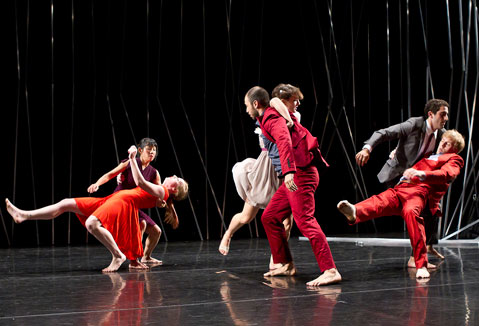Brian Brooks Moving Company at the Lobero Theatre
DANCEworks Residency Concluded with World Premiere on Friday, March 30

Brian Brooks, the fourth artist to be featured in Dianne Vapnek’s DANCEworks, found a deep groove in the Lobero stage residency program’s fascinating and durable format. These very special annual shows are the product of a month’s uninterrupted access to the Lobero main stage for rehearsal, and they typically follow a certain pattern. First there’s something familiar to establish the signature of the company, then there’s a community piece that incorporates a whole range of people from Santa Barbara, and then there’s something longer from the company’s repertoire that gets everyone working. When you come back from intermission, you get at least 40 minutes (and sometimes more) of one big new work — in this instance, a project Brooks calls Big City. Brooks hit all his marks on Friday, investing each moment of the evening with its own particular and appropriate satisfactions.
The Brooks signature piece that opened the show, “I’m Going to Explode,” is an energetic solo for the choreographer that’s set to LCD Soundsystem’s “Losing My Edge.” As a dancer, Brooks clearly has not lost his. The work begins with him in a business suit, humbly removing his shoes downstage, and ends five minutes later with Brooks dancing ecstatically in his shirt and tie, giving it up for the beat. “Explode” combined classical dance technique with the movement vocabulary of contemporary choreography, but it also had just enough of the club vernacular to give it the irreverent, ironic tone it needed.
It’s always impressive and heartwarming to see how well the DANCEworks choreographers do with the community piece, and Brooks was no exception. “Rush Hour” — the work that Brooks choreographed here and set on a group of Santa Barbara–area citizens of all ages, some dancers, some not — was a blast, from the opening subway sequence through any number of rollicking, “Grand Central Station” ensemble sections. This may have been the best anyone has done yet in terms of incorporating the widest possible spectrum of movement within the group, giving the trained dancers lots to do with their skills while still keeping the presentation balanced.
“Descent” (2011) introduced the Moving Company, and they showed a lot of what has made them a successful group. There’s a spirit of reckless exuberance in the way these wonderful athletes approach the many different lifts that Brooks throws at them. And when, as in this piece, the time comes to shift gears, they can become as delicate as the floating fabrics they balanced in the air at one point. “Descent” also showed the choreographer’s interest in the dynamics of the running body and his mastery of the power of repetition.
Brooks’s latest direction includes the installation design of Philip Treviño as a significant part of the overall effect, and Big City was a great example of this. Several dozen strips of metal about 30 feet long were hung around the stage vertically to form a kind of second proscenium. Each individual metal strip was also jointed once at about the one-third mark, so that when they were raised or lowered, they bent at the joint in a kind of dance. Into this wildly inventive and unusual metal forest of a “big city” came a stream of contenders, all attired for jobs on Wall Street, but given a certain otherworldly quality by the richly saturated hues of their red and purple business suits and revealed as dancers by their bare feet. Composer Jonathan Pratt’s music drove the whole thing forward beautifully, and the dancers each shone, flaunting the intimacy they had established with the building and the stage in a series of sequences designed to — among many other things — show what such a period of residency can do to inspire a company.



